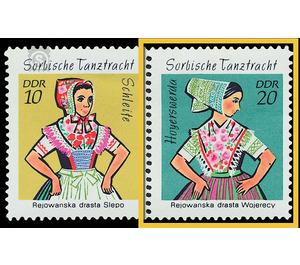Sorbian dance costumes - Germany / German Democratic Republic 1971 - 20 Pfennig
Theme: Art & Culture
| Country | Germany / German Democratic Republic |
| Issue Date | 1971 |
| Face Value | 20.00 |
| Color | multi-colored green |
| Perforation | K 13 1/2: 13 |
| Printing Type | offset |
| Stamp Type | Postage stamp |
| Item Type | Stamp |
| Chronological Issue Number | 1466 |
| Chronological Chapter | GER-DDR |
| SID | 652577 |
| In 22 Wishlists | |
Sorbische Tanztrachten Today's Sorbian costumes are remnants of formerly closed costume landscapes. Part of the female rural population of the middle and older generation still wears traditional costumes here in their daily lives. The costume of the men has already been filed in the last century, only some of its elements have been preserved to the present day. The bilingual circles of the districts of Dresden and Cottbus still have four different Sorbian costumes. Each is characterized by a variety of functional and age-related variants. Among them, especially the festive costumes are distinguished by their great wealth of forms, colors and folk art design. The Sorbian folk costumes document the creative power of the working people as well as the past as well as the present. In continuation of the 1968 published series Sorbian Festtrachten present special postage stamps represent the festive dancing costume of the girls dar. This is characterized by a special richness of color costume is created on special occasions by the female youth, even if she is not one of the permanent costume bearers. Sorbian folk art collectives like to use this costume for their youthful freshness as a stage costume. Hoyerswerdaer Tracht (20 Pfennig value) This costume landscape includes the city of Hoyerswerda and mainly the north of their district with about 25 locations. Here, too, has preserved a typical peasant costume, which is produced both in the selection of fabrics, mainly of linen and wool, as well as in a special wealth of bright colors, strange old forms, ornamental embroidery (cross, hole, tulle embroidery) and a multiplicity of function-bound and local differentiations finds its expression. The extremely richly decorated festive costumes are kept in this area as well as in Schleifer area for several decades only in the chests. There are only widespread use of the different variants of everyday dress and the age-related function-oriented church gowns, while the dance costume of the girls, which is shown on the postage stamp, is only created for a special reason.


